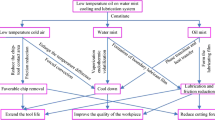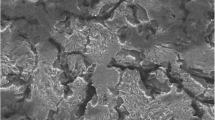Abstract
Oil-on-water (OoW) techniques, including external OoW sprayed to both the rake face and flank face (EOoWrf), as well as cryogenic air mixed with OoW (CAOoW), improve the machinability of compacted graphite iron (CGI). This paper proposes a modified material model for RuT400 CGI cutting, based on flow softening and weak thermal softening effect, as observed during split-Hopkinson pressure bar tests. Employing a modified material model and Cock-Latham damage model, a thermo-mechanical coupled finite element (FE) model, for RuT400 cutting, is presented. The simulations, considering dry cutting, EOoWrf, and CAOoW, are conducted for the purpose of revealing the causes for the RuT400 difficult-to-cut property and for establishing how the mechanism of OoW can improve cutting performance. The results show that the effective stress, required to form chip segments in RuT400 machining, is much lower than in hardened steel, so RuT400 is more likely to form a serrated chip. In dry cutting, the chip bottom surface is subject to high strain and temperature, leading to the work-material phase transformation, followed by aggravating adhesive and abrasive wears. Although EOoWrf has little influence on chip morphology and effective stress, it reduces the temperature and strain on chip bottom surface by reducing friction, thus suppressing the occurrence of phase transformation. Due to low friction and high heat exchange, CAOoW produces the lowest tool-chip interface temperature and minimal adhesive wear. For high-speed cutting of RuT400, compared to dry cutting, EOoWrf and CAOoW can effectively reduce cutting forces and maintain the tool temperature in a lower range, where low friction on tool-chip interface plays a key role. The proposed FE model can be used in the future to improve CGI’s machinability, by changing cooling parameters, tool geometry/material, and other machining variables.

















Similar content being viewed by others
Abbreviations
- Symbol:
-
Quantity
Unit
- σ :
-
Flow stress
MPa
- σ n :
-
Contact pressure
MPa
- τ :
-
Shear stress
MPa
- τ f :
-
Frictional stress
MPa
- ε :
-
Strain
- \( {\overline{\varepsilon}}^{pl} \) :
-
Equivalent plastic strain
- \( {\dot{\overline{\varepsilon}}}^{pl} \) :
-
Equivalent plastic strain rate
s−1
- \( {\dot{\varepsilon}}_0 \) :
-
Reference strain rate
s−1
- n a :
-
Temperature sensitivity parameter
- β :
-
Strain rate sensitivity parameter
- T :
-
Deformation temperature
°C
- T c :
-
Transition temperature
°C
- T ∞ :
-
Ambient temperature
°C
- T m :
-
Melting temperature
°C
- T w :
-
Surface temperature of object
°C
- A :
-
Yield strength
MPa
- B :
-
Strain hardening strength
MPa
- C :
-
Strain hardening coefficient
- m :
-
Thermal softening coefficient
- n :
-
Strain rate hardening coefficient
- a, b, d, r, s, t :
-
Material constants
- C f :
-
Fracture strain energy
- μ :
-
Coefficient of friction
- h :
-
Heat transfer coefficient
W/m2·°C
- Q w :
-
Heat generation from deformation
W/m3
- Q f :
-
Frictional heat generation
W/m2
- q :
-
Heat flux
W/m2
- v c :
-
Cutting speed
m/min
- f :
-
Feed rate
mm/r
- a p :
-
Depth of cut
mm
- F x :
-
Tangential cutting force
N
- F y :
-
Radial cutting force
N
References
Sousa JAGD, Sales WF, Machado AR (2018) A review on the machining of cast irons. Int J Adv Manuf Technol 94:4073–4092
Nayyar V, Kaminski J, Kinnander A, Nyborg L (2012) An experimental investigation of machinability of graphitic cast iron grades; flake, compacted and spheroidal graphite iron in continuous machining operations. Procedia CIRP 1(7):488–493
Abele E, Schramm B (2008) Using PCD for machining CGI with a CO2, coolant system. Prod Eng 2(2):165–169
Suhaimi MA, Park KH, Yang GD, Sharif S, Kim DW (2018) Effect of cryogenic high-speed milling of compacted graphite iron using indirect spray system. Int J Adv Manuf Technol 99:2149–2157
Varghese KP, Balaji AK (2013) Effects of tool material, tool topography and minimal quantity lubrication (MQL) on machining performance of compacted graphite iron (CGI). Int J Cast Metals Res 20(6):347–358
Kuzu AT, Bijanzad A, Bakkal M (2015) Experimental Investigations of machinability in the turning of compacted graphite iron using minimum quantity lubrication. Mach Sci Technol 19(4):559–576
Kuzu AT, Wu W, Stephenson DA, Bakkal M, Hong J, Shih AJ (2016) High-throughput dry and minimum quantity lubrication drilling of compacted graphite iron. Procedia CIRP 46:87–90
Nakamura T, Itoigawa F, Kawata K (2005) Ecological-friendly oil film on water fog metalworking fluid. Tribol Interface Eng 48(48):475–480
Li WJ, Wang B, Liu YJ, Liu GZ (2014) Study on cooling and lubrication technology of oil-on-water in cutting 1Cr18Ni9Ti stainless steel. China Mech Eng 25(6):747–750
Lin HS, Wang CY, Yuan YH, Chen ZH, Wang QM, Xiong WQ (2015) Tool wear in Ti-6Al-4 V alloy turning under oils on water cooling comparing with cryogenic air mixed with minimal quantity lubrication. Int J Adv Manuf Technol 81:87–101
Wang CY, Lin HS, Wang X, Zheng LJ, Xiong WQ (2017) Effect of different oil-on-water cooling conditions on tool wear in turning of compacted graphite cast iron. J Clean Prod 148:477–489
Gok A (2017) 2D numeric simulation of serrated chip formation in orthogonal cutting of AISI316h stainless steel. Mater Technol 51(6):953–956
Zang J, Zhao J, Li AH, Pang JM (2018) Serrated chip formation mechanism analysis for machining of titanium alloy Ti-6Al-4 V based on thermal property. Int J Adv Manuf Technol 98:119–127
Gok K, Sari H, Gok A, Neseli S, Turkes E, Yaldiz S (2015) Three-dimensional finite element modeling of effect on the cutting forces of rake angle and approach angle in milling. Proc Inst Mech Eng E J Proc Mech Eng 231(2):83–88
Gok K (2015) Development of three-dimensional finite element model to calculate the turning processing parameters in turning operations. Measurement 75:57–68
Zong WJ, Li D, Cheng K, Sun T, Liang YC (2007) Finite element optimization of diamond tool geometry and cutting-process parameters based on surface residual stresses. Int J Adv Manuf Technol 32:666–674
Wu HB, Zhang SJ (2015) Effects of cutting conditions on the milling process of titanium alloy Ti6Al4V. Int J Adv Manuf Technol 77:2235–2240
Mohammed WM, Ng E, Elbestawi MA (2011) Modeling the effect of the microstructure of compacted graphite iron on chip formation. Int J Mach Tool Manu 51(10):753–765
Mohammed WM, Ng E, Elbestawi MA (2012) Modeling the effect of compacted graphite iron microstructure on cutting forces and tool wear. CIRP J Manuf Sci Technol 5(2):87–101
Ljustina G, Larsson R, Martin F (2014) A FE based machining simulation methodology accounting for cast iron microstructure. Finite Elem Anal Des 80(2):1–10
Sima M, Özel T (2010) Modified material constitutive models for serrated chip formation simulations and experimental validation in machining of titanium alloy Ti-6Al-4V. Int J Mach Tool Manu 50(11):943–960
Tang DW, Wang CY, Hu YN, Yu DH, Song YX (2009) Constitutive equation for hardened SKD11 steel at high temperature and high strain rate using the SHPB technique. Proc SPIE 7522:75226B–75226B-12
Sun J, Guo YB (2009) Material flow stress and failure in multiscale machining titanium alloy Ti-6Al-4V. Int J Adv Manuf Technol 41:651–659
Chen G, Ren CZ, Yang XY, Jin XM, Guo T (2011) Finite element simulation of high-speed machining of titanium alloy (Ti–6Al–4V) based on ductile failure model. Int J Adv Manuf Technol 56:1027–1038
Chen G, Ke ZH, Ren CZ, Li J (2016) Constitutive modeling for Ti-6Al-4V alloy machining based on the SHPB tests and simulation. Chin J Mech Eng 29(5):962–970
Duan CZ, Kong WS, Hao QL, Zhou F (2013) Modeling of white layer thickness in high speed machining of hardened steel based on phase transformation mechanism. Int J Adv Manuf Technol 69:59–70
Kim DM, Bajpai V, Kim BH, Park HW (2015) Finite element modeling of hard turning process via a micro-textured tool. Int J Adv Manuf Technol 78:1393–1405
Johnson GR, Cook WH (1983) A constitutive model and data for metals subjected to large strains, high strain rates and high temperatures. In: Proceedings of the 7th International Symposium on Ballistics. The Hague. International Ballistics Committee, Netherlands, pp 541–547
Takuda H, Mori K, Hatta N (1999) The application of some criteria for ductile fracture to the prediction of the forming limit of sheet metals. J Mater Process Technol 95:116–121
Cockcroft MG, Latham DJ (1968) Ductility and the workability of metals. J Inst Met 96:33–39
Wang CY, Ding F, Tang DW, Zheng LJ, Li SY, Xie YX (2016) Modeling and simulation of the high-speed milling of hardened steel SKD11 (62 HRC) based on SHPB technology. Int J Mach Tool Manu 108:13–26
Lu JP, Chen JB, Fang QH, Liu B, Liu YW, Jin TF (2016) Finite element simulation for Ti-6Al-4V alloy deformation near the exit of orthogonal cutting. Int J Adv Manuf Technol 85(9–12):2377–2388
Bondy M, Jensen MR, Magliaro J, Altenhof W (2017) Finite element modeling of a novel cutting deformation mode of AA6061-T6 tubes employing higher order Lagrangian element formulations. Int J Impact Eng 110:288–298
Nayyar V, Md A, Zubayer K, Jacek AK, Lars N (2013) An experimental investigation of the influence of cutting-edge geometry on the machinability of compacted graphite iron. Int J Manuf Mater Mech Eng 3(1):1–25
Jiang F, Zhang T, Yan L (2016) Estimation of temperature-dependent heat transfer coefficients in near-dry cutting. Int J Adv Manuf Technol 86:1–12
Filice L, Micari F, Rizzuti S, Umbrello D (2006) A critical analysis on the friction modelling in orthogonal machining. Int J Mach Tool Manu 47:709–714
Fukumasu NK, Pelegrino PL, Cueva G, Souza RM, Sinatora A (2005) Numerical analysis of the stresses developed during the sliding of a cylinder over compact graphite iron. Wear 259(7–12):1400–1407
Wang CY, Xie YX, Zheng LJ, Qin Z, Tang DW, Song YX (2014) Research on the chip formation mechanism during the high-speed milling of hardened steel. Int J Mach Tool Manu 79(4):31–48
Acknowledgments
We are grateful to Guangxi Yuchai Machinery Group Co., Ltd. for providing cast iron samples for this study.
Funding
This study received financial supports from the Major National Science and Technology Projects in China (No. SK201901A31-04), namely Demonstration application of localization of super-hard tools for automobile engine block and cylinder head production, and the Key Program of the National Natural Science Foundation of China-Guangdong Joint Fund (Grant No. U1201245).
Author information
Authors and Affiliations
Corresponding author
Additional information
Publisher’s note
Springer Nature remains neutral with regard to jurisdictional claims in published maps and institutional affiliations.
Rights and permissions
About this article
Cite this article
Ding, F., Wang, C., Lin, H. et al. Research on machining compacted graphite iron under oil-on-water cooling and lubrication conditions based on modified material model. Int J Adv Manuf Technol 105, 5061–5079 (2019). https://doi.org/10.1007/s00170-019-04543-y
Received:
Accepted:
Published:
Issue Date:
DOI: https://doi.org/10.1007/s00170-019-04543-y




